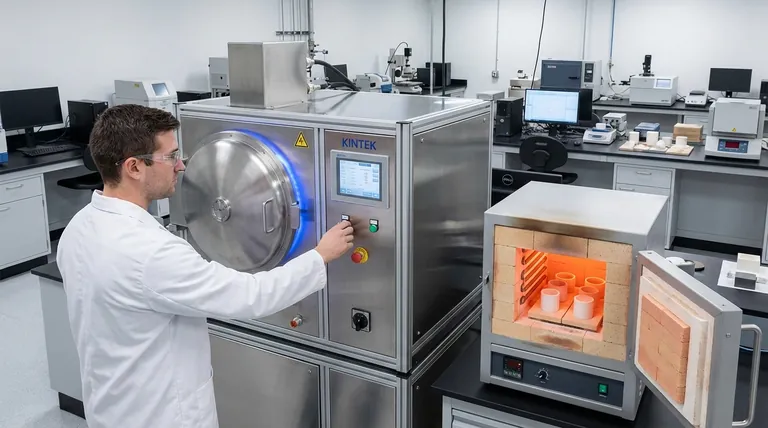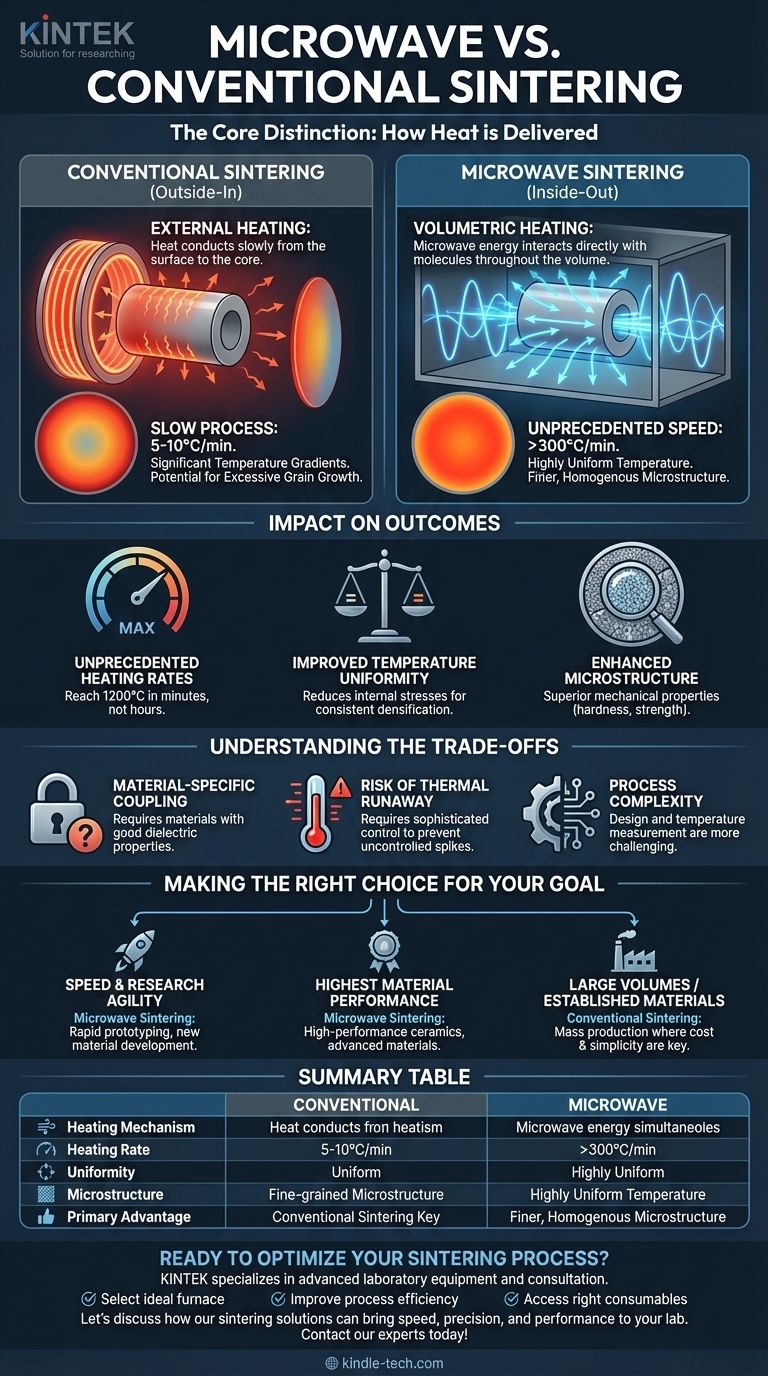In short, microwave sintering heats a material from the inside out, while conventional sintering heats it from the outside in. This fundamental difference in heat delivery allows microwave sintering to be significantly faster and more energy-efficient, often resulting in materials with a finer, more uniform microstructure.
The core distinction lies not just in the heat source, but in the heating mechanism itself. Conventional methods rely on slow thermal conduction from an external source, whereas microwave sintering uses electromagnetic energy to generate heat volumetrically and simultaneously throughout the entire part.

The Fundamental Difference: How Heat is Delivered
To truly grasp the advantages of each method, you must first understand how heat is transferred to and through the material being processed. The mechanism of heat delivery dictates the speed, efficiency, and outcome of the entire sintering process.
Conventional Sintering: External Heating
In a conventional furnace, heating elements radiate heat into the chamber. This heat is absorbed by the surface of the component, a "green body," and must then slowly conduct from the outside toward the core.
This process is inherently slow. The heating rates are limited by the material's thermal conductivity and the need to avoid thermal shock, typically ranging from 5 to 10°C per minute. This slow, outside-in approach can create significant temperature gradients, where the surface is much hotter than the interior during the heating phase.
Microwave Sintering: Volumetric Heating
Microwave sintering operates on a completely different principle. Instead of relying on external radiation and conduction, it uses microwave energy to directly interact with the molecules of the material itself.
This interaction causes the material's internal dipoles and ions to rapidly oscillate, generating heat throughout the entire volume of the component simultaneously. Because the heat is generated internally, it does not need to conduct from the surface. This is known as volumetric heating.
The Impact on Sintering Outcomes
This distinction between external and volumetric heating has profound consequences for the sintering process and the final properties of the densified material.
Unprecedented Heating Rates
Because heat is generated everywhere at once, microwave sintering can achieve extremely high heating rates. While a conventional furnace might take hours to reach a target temperature, advanced sintering methods that use internal heating can achieve rates well over 300°C per minute. This means a target temperature of 1200°C can be reached in minutes, not hours.
Improved Temperature Uniformity
By heating from within, microwave sintering can significantly reduce or even reverse the temperature gradients seen in conventional methods. The core of the material can heat up as fast as, or even faster than, the surface. This uniform temperature distribution is critical for achieving consistent densification and avoiding internal stresses that can lead to defects.
Enhanced Microstructure
The combination of rapid and uniform heating has a direct impact on the material's final microstructure. The shorter time spent at high temperatures limits the opportunity for excessive grain growth. This often results in a final product with a finer, more homogenous grain structure, which typically translates to superior mechanical properties like hardness and strength.
Understanding the Trade-offs
While microwave sintering offers significant advantages, it is not a universal solution. It introduces its own set of challenges and considerations that are not present in established conventional methods.
Material-Specific Coupling
A material must be able to "couple" with microwave energy to be heated effectively. Materials with poor dielectric properties will not absorb microwave energy and will not heat up. This makes material selection a critical parameter for process success.
Risk of Thermal Runaway
The very efficiency of microwave heating can also be a liability. As some materials get hotter, they become better at absorbing microwave energy, creating a feedback loop that can lead to a rapid, uncontrolled temperature spike known as thermal runaway. This requires sophisticated power control and real-time temperature monitoring to prevent.
Process and Equipment Complexity
Designing a microwave sintering system that provides a uniform electromagnetic field is more complex than building a conventional resistance furnace. Furthermore, accurately measuring the temperature inside a microwave field is a non-trivial challenge that requires specialized probes, like fiber optic sensors, rather than standard thermocouples.
Making the Right Choice for Your Goal
The choice between microwave and conventional sintering depends entirely on your specific objectives, materials, and production scale.
- If your primary focus is speed and research agility: Microwave sintering is superior for rapid prototyping and developing new materials due to its incredibly fast heating cycles.
- If your primary focus is achieving the highest material performance: Microwave sintering's ability to produce fine, uniform microstructures makes it ideal for high-performance ceramics and advanced materials.
- If your primary focus is processing large volumes or simple, established materials: Conventional sintering remains a robust, reliable, and well-understood choice for mass production where speed is less critical than cost and simplicity.
Ultimately, choosing the right sintering technology is about matching the heating mechanism to your material and desired outcome.
Summary Table:
| Feature | Conventional Sintering | Microwave Sintering |
|---|---|---|
| Heating Mechanism | External radiation & conduction (outside-in) | Internal volumetric heating (inside-out) |
| Typical Heating Rate | 5-10°C per minute | Can exceed 300°C per minute |
| Temperature Uniformity | Significant gradients (surface hotter than core) | Highly uniform, reduces internal stresses |
| Resulting Microstructure | Potential for excessive grain growth | Finer, more uniform grain structure |
| Primary Advantage | Robust, simple, ideal for mass production | Speed, energy efficiency, superior material properties |
Ready to Optimize Your Sintering Process?
Whether you are developing next-generation ceramics or scaling up production of established materials, choosing the right sintering technology is critical. KINTEK specializes in providing advanced laboratory equipment and expert consultation to help you achieve your material science goals.
We can help you:
- Select the ideal furnace for your specific materials and application.
- Improve process efficiency and final product quality.
- Access the right consumables to ensure consistent, reliable results.
Let's discuss how our sintering solutions can bring speed, precision, and performance to your lab.
Contact our experts today for a personalized consultation!
Visual Guide

Related Products
- Vacuum Heat Treat and Molybdenum Wire Sintering Furnace for Vacuum Sintering
- Vacuum Heat Treat Sintering Brazing Furnace
- Laboratory Quartz Tube Furnace Tubular RTP Heating Furnace
- High Temperature Muffle Oven Furnace for Laboratory Debinding and Pre Sintering
- 1700℃ Laboratory Quartz Tube Furnace with Alumina Tube Tubular Furnace
People Also Ask
- Where is vacuum furnace used? Essential for Aerospace, Medical, and High-Tech Manufacturing
- What are the advantages of vacuum sintering? Achieve Superior Purity, Strength, and Performance
- What is the standard thickness of plating? Optimize Durability, Corrosion & Cost
- What is the sintering process of powder metallurgy? Transform Powder into Durable Metal Parts
- What is sintering reaction? Transform Powders into Dense Solids Without Melting



















